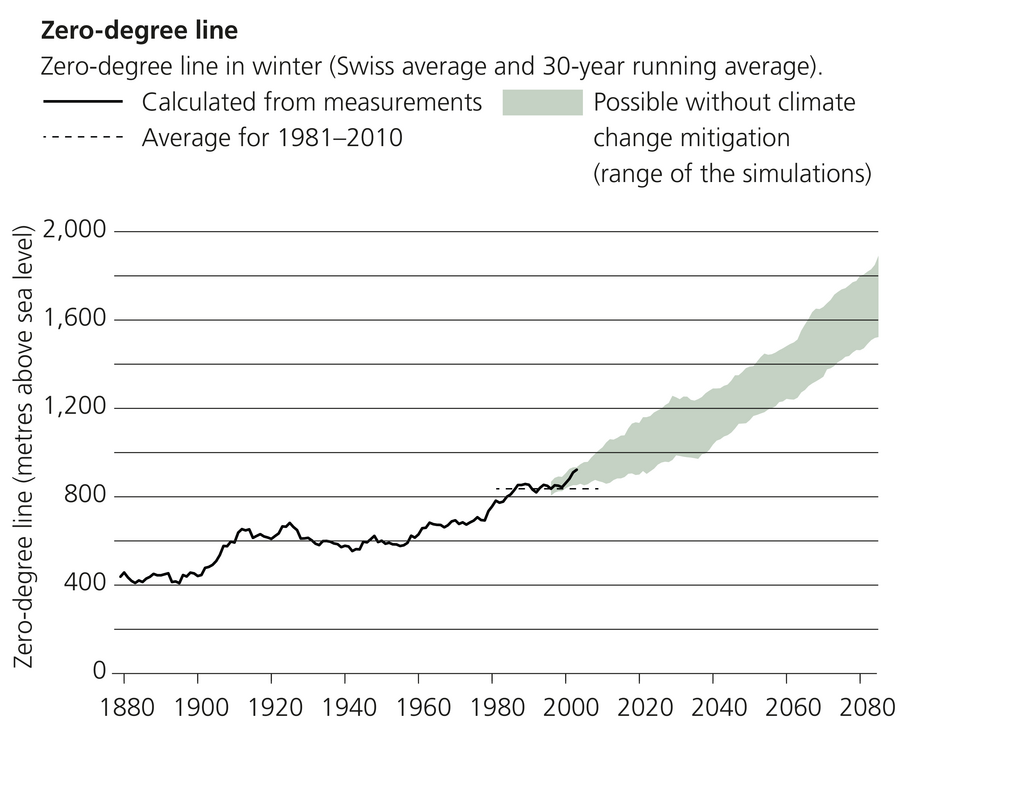Winters will be significantly warmer by the middle of the century. Although there will be more precipitation, it will fall more frequently in the form of rain because of the higher temperatures. Particularly in lower-lying regions, it will snow less often and in smaller quantities. The snowy areas of Switzerland will therefore shrink considerably.
The content of this page is based on the Swiss climate scenarios CH2018. In the meantime, the new Swiss climate scenarios have been published as part of the Climate CH2025 project. They expand on the previous results with longer measurement series and information from new, high-resolution climate models. The qualitative statements remain unchanged from the CH2018 climate scenarios, but the quantitative estimates have changed. It is recommended that the results of Climate CH2025 be used.
|
Winter temperature |
Elevation increase of the zero-degree line in winter |
|---|---|---|
Possible around mid-century |
+2 °C to +3.5 °C |
400 m to 650 m |
Possible by the end of the century |
+3 °C to +5.5 °C |
700 m to 1050 m |
In winter, it is on average 3.5 °C warmer than now. There is less snowfall in terms of both amount and frequency. Snowfall amounts in low-lying areas are reduced by half. The elevation of the zero-degree line has risen by 650 metres and is situated at about 1,500 metres above sea level in winter.
The climate warming experienced to date has already had a significant effect on the snow and ice conditions. The Alpine glaciers have lost about 60 percent of their volume since 1850. Moreover, at altitudes below 800 meters, the number of days with snowfall has halved since 1970.
Switzerland’s average temperatures in winter will continue to rise in the future. By mid-century, the zero-degree line could increase in elevation from today’s level at 850 metres to up to 1,500 meters above sea level. Snowfall will change as the result of two opposing effects: Increases in temperature will lead to a greater proportion of precipitation falling as rain, but the total amounts of precipitation in winter will also increase.
On balance, however, our country will experience a considerable reduction in both snowfall and snow cover. This will predominantly affect the low-lying areas, particularly in springtime. Below altitudes of 1,000 metres, snow cover will approximately halve by the middle of the century; by the end of the century, it will probably diminish by over 80 percent.
The higher altitudes will also be affected. The large majority of Alpine locations is expected to suffer reductions in snowfall, particularly in the spring. The decreased amounts of snow will also affect the glaciers: They will not be fed with enough snow, and they will also melt at a faster rate.
In winter, small-scale phenomena such as inversion layers and cold-air pools often dictate local weather patterns. Consequently, snowfall amounts fluctuate widely, and so it is difficult to simulate them in a climate model. This means that there could also occasionally be winters in the future with plenty of snow.
The changes in snowfall and snow cover not only have an effect on winter tourism but are also relevant for sectors such as hydropower and transportation.
The key messages can also be found in the CH2018 brochure, which is available in printed form or as an electronic download.
Last modification 10.10.2025









